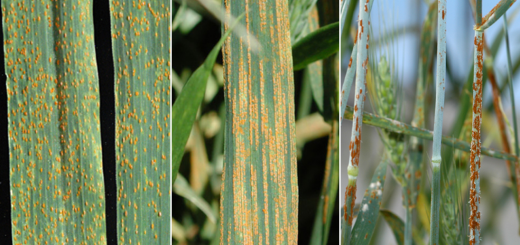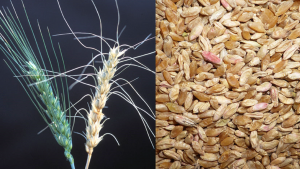#078: Evolution of Mycorrhizae
Arbuscular mycorrhizae have been around since plants began to colonize the land and were probably instrumental in that transition. Ectomycorrhizae and ericaceous mycorrhizae evolved during the time of the dinosaurs and were successful because of their ability to extract organic nutrients from the well-defined soil. Orchid mycorrhizae were the last to evolve. This probably happened around the same time as mammal lineages started to diverge. Despite the tens to hundreds of millions of years of symbiosis, coevolution does not appear to play a large role in the evolution of modern mycorrhizal partners.
Arbuscular mycorrhizae (AM) were the first mycorrhizae to evolve. Land plants evolved around 475 million years ago (mya), but none of the fossils from this time period are detailed enough to show mycorrhizae or other endophytes. Instead, “molecular clock” analysis (which uses DNA mutation rates to estimate dates of evolution) is used to date the evolution of AM. This analysis suggests that the Glomeromycota (fungi that form AM, FFF#015) evolved between 353 and 465 mya. There is some fossil evidence to back this up: fossilized Glomeromycota-like spores have been found dating back to around 460 mya. This evidence suggests that the formation of AM allowed plants to colonize the land. At that time period, the land would have been covered by at most a rudimentary soil, so nutrients like nitrogen and phosphorous would have been inaccessible to plants. Similarly, carbon would have been unavailable to saprotrophic fungi. The evolution of AM would have solved both of these problems and allowed plants to conquer the terrestrial world.
Primitive arbuscules and vesicles can be seen in Rhynie Chert fossils, demonstrating that the AM relationship was well-established by around 400 mya. Of course, there is no way to verify that these structures represent mutualistic relationships, but their remarkable similarity to the structures formed by modern AM suggests that they served a similar function. An interesting conclusion can be drawn from the above analysis: the ability to form AM is the ancestral state for all land plants. This means that all plants that do not form AM have lost that ability at some point over their evolutionary history. Given that over 80% of extant (currently living) plant species form AM, neither of these points is particularly surprising.
Ectomycorrhizae (EM) evolved next. EM do not appear in the fossil record until around 150 mya (late Jurassic, early Cretaceous). This follows the appearance of the first Pinaceae species during the late Triassic period (around 200 mya). Modern Pinaceae species are predominantly ectomycorrhizal, so EM likely began evolving with the earliest Pinaceae plants. EM must have evolved at least twice with respect to plants: once in the Pinaceae and once in the ancestor of the Gnetales and Angiosperms. This second evolution occurred somewhat later, at around the same as the flowering plants.
Among fungi, EM have clearly evolved multiple times, since the Ascomycota and Basidiomycota (both of which are EM-forming clades) diverged before the evolution of EM. It is likely that EM fungi evolved several times, but an exact number remains elusive. Modern EM fungi evolved from saprophytic fungi. Many still contain genes that allow the fungi to decompose organic matter, albeit not as well as non-EM saprotrophs. The ability to obtain nutrients from organic sources is likely what spurred on the evolution of EM despite the preexistence of a fully functioning mycorrhizal system. Because they are descended from saprotrophs, EM fungi have the ability to obtain nitrogen and phosphorous from organic matter, which would give the mutualism an advantage over AM in forests rich with organic litter. Different EM fungi have retained different decomposition genes, indicating that certain fungi may be more successful at certain times or in certain areas. This observation could explain the phenomenon of succession of EM fungi (see FFF#075 for more on EM succession).
Despite the multiple evolutions of EM in both plants and fungi, modern EM structures all look identical. Once again, fungi have given us a remarkable example of convergent evolution (the same selective pressures result in the formation of similar structures across different species). Of course, not all angiosperms or Pinaceae form EM. It is likely that these plants represent a loss of the ability to form EM. Some of these have reverted back to AM, while others have become nonmycorrhizal. The reasons behind these changes are unclear, but one theory is that non-EM plants evolved to block certain fungal pathogens. A few plants usually classified as EM will also form AM under the right conditions, possibly indicating that the plants are not actively excluding AM fungi. Some species in the Pinaceae will form unusual mycorrhizae called ectendomycorrhizae with species of Wilcoxina (Ascomycota, Pezizomycetes, Pezizales, Pyronemataceae). These fungi form a sheath and Hartig net like EM, but also penetrate the cell. How exactly these fit into the evolution of EM is unclear. Much more research needs to be done to resolve the evolutionary history of EM fungi.
Ericaceous mycorrhizae likely developed next. Fossil evidence shows that the Ericales began evolving during the Cretaceous period, so primitive ericaceous mycorrhizae probably arose around 140 mya. These early associations likely started out as EM-like mycorrhizae. Over time, the Ericales developed distinctive structures from this ancestral state, resulting in ericoid mycorrhizae. Arbutoid mycorrhizae evolved in a similar manner, but with a slightly different outcome. Monotropoid mycorrhizae probably evolved from arbutoid mycorrhizae. These relationships are not fully understood, so future research will hopefully help elucidate the evolution of ericaceous mycorrhizae.
Orchid mycorrhizae were probably the last to evolve, though the exact time is difficult to determine. Neither orchids nor their associated fungi fossilize very well, so fossil evidence for this association is severely lacking. Orchids probably evolved 54 mya (during the time when modern mammal lineages were evolving). Given that mycorrhizal association with a fungus is an essential part of orchid biology, the evolution of orchid mycorrhizae probably facilitated the divergence of the orchid family from similar contemporary plants.
Given how essential mycorrhizae are to a majority of plants on Earth, it may surprise you to learn that there is almost no coevolution between mycorrhizal plants and mycorrhizal fungi. In the strictest sense, the term “coevolution” refers to reciprocal genetic change among symbionts at the species or population level. This can be seen in disease-causing fungi, where plant resistance genes change in response to changed fungal pathogenicity genes. In mycorrhizal fungi, however, there appears to be no gene-for-gene coevolution. Mycorrhizal fungi and plants do change in response to environmental conditions, but this appears to be parallel evolution (the symbionts evolve to tackle the problem independently, without influencing one another). It is likely that coevolution occurred during the initial evolution of each type of mycorrhiza, but no concerted change can be seen afterwards. This unusual situation is just another one of the mycorrhizal mysteries that have yet to be solved.
See Further:
http://www.davidmoore.org.uk/assets/mostly_mycology/diane_howarth/evolution.htm
http://www.planta.cn/forum/files_planta/evolution_of_mycorrhiza_systems_783.pdf
http://mycorrhizas.info/evol.html
http://www.davidmoore.org.uk/assets/mostly_mycology/diane_howarth/ectendo.htm
Other Sources:
http://www.ucmp.berkeley.edu/tertiary/eocene.php


![#015: Characteristics of Phylum Glomeromycota [Archived]](https://www.fungusfactfriday.com/wp-content/themes/hueman/assets/front/img/thumb-medium-empty.png)





![#011: Characteristics of Kingdom Fungi [Archived]](https://www.fungusfactfriday.com/wp-content/themes/hueman/assets/front/img/thumb-small-empty.png)


1 Response
[…] Fossils of early glomeromycotan fungi date as early as 400 million years ago and correspond with the evolution of land plants. Indeed, taxonomic relationships suggest that the common ancestor of all land plants formed arbuscular mycorrhizas. Both of these lines of analysis suggest that the Glomeromycota were crucial in helping plants colonize the land (for more on the evolution of mycorrhizas, see FFF#078).1 […]